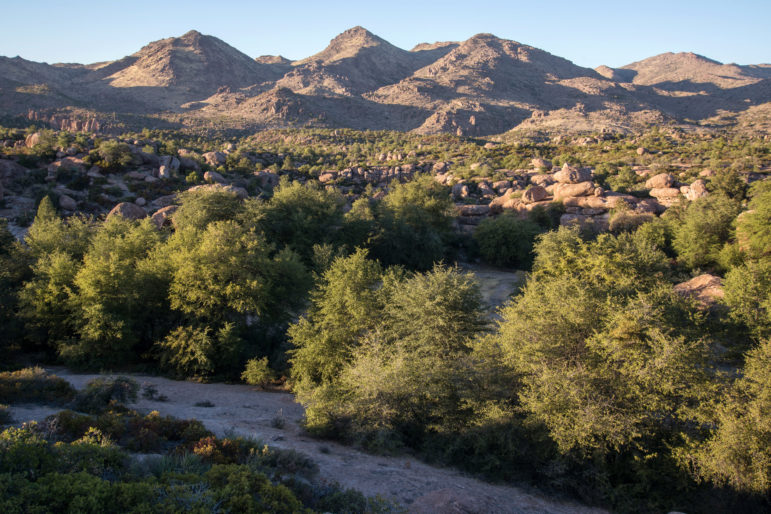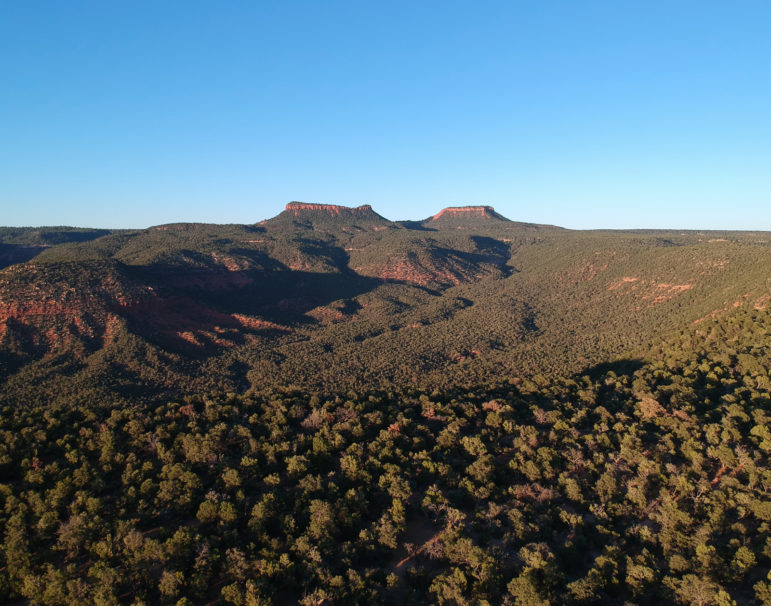TWH – On Jan. 13, Apache Stronghold, filed three legal actions in an attempt to block the land exchange of the Oak Flat federally-protected area to the international mining company, Rio Tinto, and its subsidiary Resolution Copper Mining. The deal Rio Tinto negotiated with the U.S. government involved a land exchange for the Oak Flat area.

Emory oak grove at Oak Flat, AZ – Image credit: Copyright © 2020 Elias Butler Photography All Rights Reserved – CC-BY-SA-4.0
The Apache know this land as Chi’chil Bildagoteel, and along with other Native American tribes hold Chi’chil Bildagoteel as sacred. It measures about 2,422 acres (980 ha). Rio Tinto’s interest in the land is the large copper deposit beneath.
For centuries, the San Carlos Apache have related to Chi’chil Bildagoteel (Oak Flat), and use it to hold their ceremonies and the bodies of their dead.
Oak Flat is within the Tonto National Forest and also open to secular use as a campsite, a base for hiking, rock climbing, and simply being in nature. The area is world-renowned for rock climbing and is the site for competitions.
In late 2019, climbing enthusiasts and Native tribes joined forces to try to save Oak Flat, and oppose the land swap to Resolution Copper Mining since the “block caving” technique proposed would utterly destroy the land for Natives, as well as climbers.
The following Native Americans have expressed opposition to this exchange: The San Carlos Apache Tribe, White Mountain Apache Tribe, Fort McDowell Yavapai Tribe, Jicarilla Apache Tribe, InterTribal Council of Arizona, and the National Congress of American Indians.
Rep. Raul Grijalva (D-AZ) has also introduced the “Save Oak Flat Act” in the House of Representatives.
It is important to note that Rio Tinto is the same mining company responsible for the destruction of the 46,000-year-old Juukan Gorge caves in Western Australia that are sacred to the Aboriginal people of the region.
Legal issues
The three legal actions of Apache Stronghold consist of a lien, a lawsuit, and a temporary restraining order (TRO). Apache Stronghold acted on behalf of the Apache traditional religious and cultural leaders. The TRO would block the land exchange while the lawsuit works its way through the courts. That lawsuit argues that the land exchange of Chi’chil Bildagoteel (Oak Flat) would violate the Religious Freedom Restoration Act. It would also violate their religious freedoms under the First Amendment.
The court will hear the TRO on Jan. 27. A legal clock has begun to tick. The U.S. Forest Service has issued a Final Environmental Impact Statement (FEIS) on Jan. 15. That publication triggered a 60-day objection period before the exchange could begin.
According to an article in the Arizona Silver Belt, “The FEIS publication only makes it technically possible for the U.S. Forest Service to try to convey the land to RCM [Resolution],” stated Apache Stronghold’s attorney Michael Nixon.
“But the lien is like a giant Apache shield over Oak Flat, protecting it at least until the entire case is all over, including all appeals.”
Native Americans talk about Chi’chil Bildagoteel.
According to Last Real Indians, former San Carlos Apache Tribal Chairman, Dr. Wendsler Nosie, Sr. said, “Oak Flat is holy and sacred. Chi’chil Bildagoteel is central to our traditional religion and identity as Apache people. Giving away our sacred land for destruction by a foreign mining company destroys our ability to practice our religion. Besides, the United States government never legally took Chi’chil Bildagoteel away from us. It is still Apache land.”
The Apache argue that Oak Flat lies in their territory per the 1852 Treaty of Santa Fe. This treaty marks the only agreement about aboriginal lands between the Apache and the US government.
In the Arizona Silver Belt article, Nosie compared this land exchange to past military seizures of Indian land. He said, “What was once gunpowder and disease is now replaced with bureaucratic negligence and mythologized past that treats us, as Native people, as something invisible or gone.”
Native America Calling hosts an online radio call-in show about Native American issues. On Jan. 21, Clark Tenakhongva, Vice-Chair of the Hopi Tribe, Roger Featherstone, director of Arizona Mine Reform Coalition, and Wendsler Nosie, Sr., of Apache Stronghold, spoke about Chi’chil Bildagoteel (Oak Flat).
Nosie described the conflict in religious terms, “It’s a sacred site and a holy place. It’s always been a religious battle for me.”
He feels that freedom of religion does not extend to Native Americans and like his religion is on trial.
Part of the problem may lie in incorrect translations of Apache words and concepts. Nosie said people had badly translated words for Apache religious concepts and beings.
For example, the closest English language word for a type of Apache spiritual figure would be “angel” or “saint.” People, however, have translated that word as “clown dancer” or “devil dancer.”
Nosie described the land exchange as an “Evil that has come to this part of the country. I tell people [it] is not the White people. It’s this way of life. It’s the capitalism that is destroying so many different things.”
He compared what is happening in Chi’chil Bildagoteel to what happened in Europe, saying, “Even in Europe before they were colonized into this capitalist world … even White people had a … cultural way before the dominance of Christianity came to them.”
The Apache are not rolling in cash. Resolution and its supporters argue that the copper mine would produce a $61 billion impact over 60 years. They claim that it would produce 1,500 jobs. That fails to impress Nosie.
He said the Apache are “going to be forced to learn those things which really takes Indian people and this country in a direction that we shouldn’t go, because were killing all the environment and all the religious ways.”
Nosie said, “It’s holy and sacred … we’re killing these places … Once they’re all gone, like my mother used to tell me, … Earth will do what it has to do, clean itself.”
It’s not just about one sacred rock
Badger-Two Medicine is another Native site that has repeatedly and successfully fought the claims of gas and oil extraction companies. Badger-Two Medicine is in Montana, and sacred to the Blackfeet tribe.
In August of 2020, the Blackfeet drafted its own legislation which Sen. Jon Testor (D-MT) introduced as S.B. 4288, “The Badger-Two Medicine Protection Act.” According to High Country News, the bill would permanently protect 130,000 acres of the Badger-Two Medicine as a “cultural heritage area,” and be “a first-of-its-kind designation that could potentially usher in a new national system for protecting public lands in Indian Country.”
The moderator from Native America Calling recalled an incident connected to Badger-Two Medicine. Someone from the mining company wanted to know which were the “sacred rocks.” If the mining company knew, they could then avoid them. She then asked, “What are the challenges of explaining it’s not about one sacred rock?”
Nosie responded, “It has been challenging because they don’t realize that everything interacts together. If you hurt one part, it’s just like a body. If an arm is taken away, what happens to the rest of that body? … It creates an imbalance. There’s only certain places where you can do things. There are places that are male and female. We talk about Oak Flat. It’s a female. It provides water.”
Nosie reported that he has met with Rep. Deb Haaland (D-NM) about this issue. President Biden has nominated Haaland for the position of Secretary of the Interior. If confirmed, she would be the first Native American to head this agency.
In the past, Nosie has spoken about these issues with McCain and Obama, among others. He felt that many politicians kept promoting the economic benefits of developments, but failed to remember how U.S. policies created Native American poverty.
Clark Tenakhongva reported that the Hopi have spiritual ties across the U.S. southwest. The Hopi have not yet gone on the record as supporting Apache efforts at Chi’chil Bildagoteel.
Bear Ears
The Hopi are more directly involved in another sacred site, Bears Ears. Trump had issued an executive order about Bears Ears, which reduced the size of the national monument from 1.35 million acres (546,325 ha) to 200,000 acres (80,937 ha). Biden has reversed that executive order.

Bears Ears National Monument – Image credit: brucerinehart (Bruce Rinehart) – CC BY-SA 4.0
According to Tenakhongva, five tribes are currently litigating the issue in D.C. courts. He said, “Once that happens the push is to go forward with a better concrete legislation from Congress.”
He wants to secure Bears Ears as a national park through Congressional action. This would immunize it from arbitrary reductions by Presidential executive order.
The environmental impact on Oak Flat/ Chi’chil Bildagoteel
According to Arizona Mining Reform, Arizona has seen 21 years of drought. The proposed mining project will use about 40,000 acre-feet of water per year. In comparison, the city of Tempe, Arizona, (population of 180,000) uses about the same amount of water.
Featherstone thought the mine would draw all the water from the nearby desert area to keep the mine running. This loss of water could impact the nearby San Carlos Apache reservation.
On Native America Calling, Roger Featherstone discussed the environmental impact of the proposed mine. It would leave a 43 mile (69.2 km) footprint, damaging “16,000 acres [6,474 ha] from one side to the other.”
Resolution Mining plans to use “block caving” mining technique. Featherstone described that as “an upside-down open pit.”
First, they would drill down 7,000 feet (2133.6 m) below the surface to get below the ore deposit. They would then create a blast to cause the ore to collapse onto the floor of the mine. At some point, all the ore will be gone. The mine will then fail to generate a profit. By that time, he estimated that the blasts and collapses would have created a crater on the surface. It would be about two miles (3.2 km) wide and 1,000 feet (304.8 m) deep.
Nosie described a bleak and spiritually discordant future where “You sing the songs. You pray this way …. You go there and it’s a big copper pit.”
The Wild Hunt is not responsible for links to external content.
To join a conversation on this post:
Visit our The Wild Hunt subreddit! Point your favorite browser to https://www.reddit.com/r/The_Wild_Hunt_News/, then click “JOIN”. Make sure to click the bell, too, to be notified of new articles posted to our subreddit.
